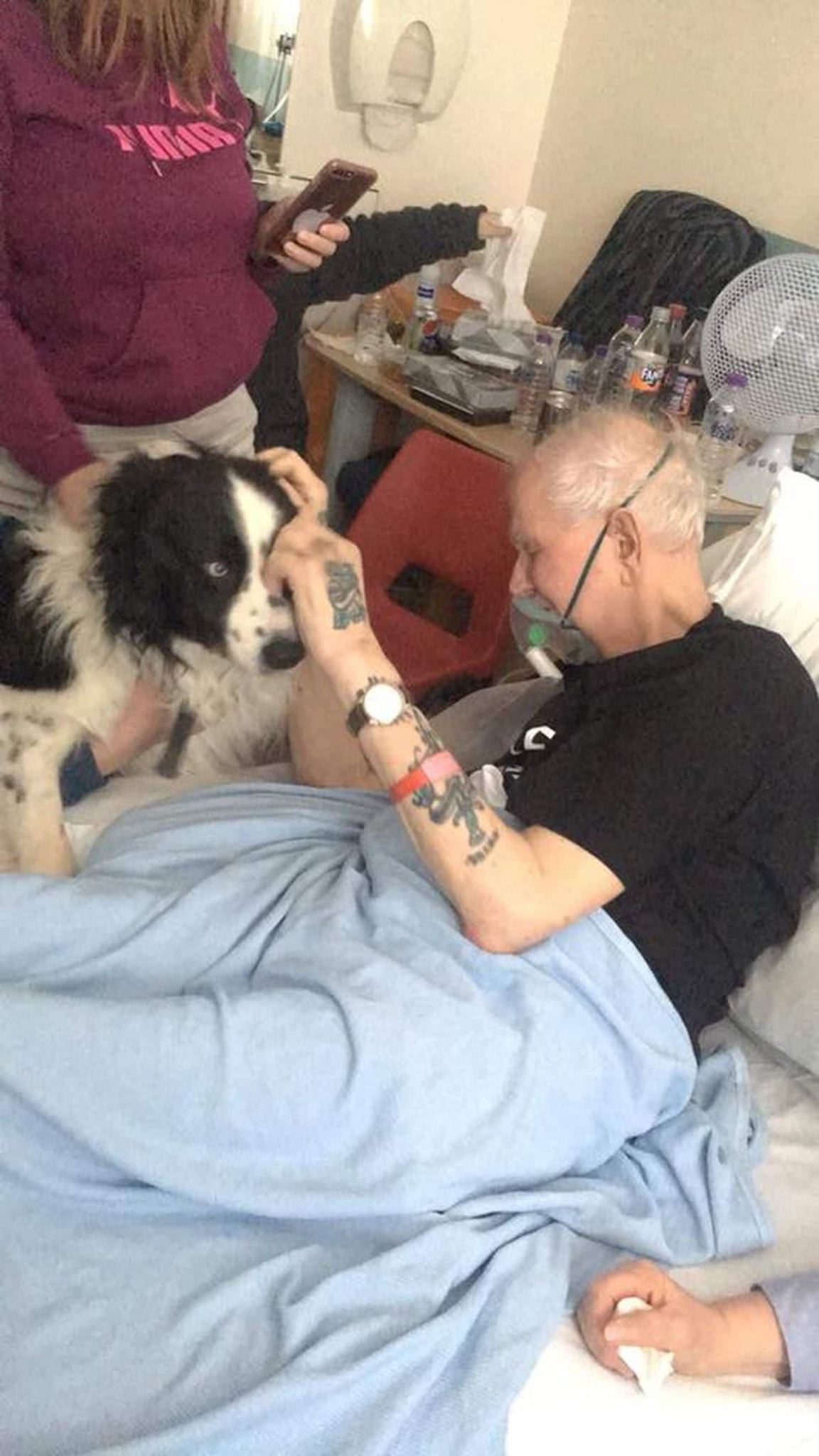He Didn’t Need More Medicine… He Just Needed to Hold His Best Friend Again

He Didn’t Need More Medicine… He Just Needed to Hold His Best Friend Again
In the sterile hush of a hospital room, where the steady beep of monitors and the faint hum of fluorescent lights become the soundtrack of isolation, an elderly man lay in his bed, tethered to oxygen tubes and IV lines. Days blurred into one another, each one a monotonous cycle of treatments, check-ups, and the quiet ache of loneliness. He wasn’t longing for the comforts of home—the familiar armchair by the window or the scent of fresh-brewed coffee. No, what gnawed at his heart most was the absence of his loyal companion: his beloved dog, whose warm brown eyes had always waited patiently by the door, tail thumping in rhythmic joy at his return. In those long, silent hours, he whispered to his daughter during one of her visits, his voice frail but resolute: “Can you bring him to see me… just once?” It was a simple request, born not from whimsy but from a deep-seated need for connection. And when that door finally creaked open, and the soft patter of familiar paws echoed on the linoleum floor, his face lit up with a smile that spoke volumes. No words were necessary. Just a look, a gentle touch—two hearts, forever intertwined, even amid sickness. The dog, oblivious to the concept of hospitals or illness, knew only one truth: “My human needs me. I’m coming.”

This poignant scene isn’t just a figment of imagination; it mirrors countless real-life stories where the bond between humans and their pets transcends physical barriers, offering solace in times of vulnerability. In hospitals around the world, where patients grapple with pain, fear, and emotional exhaustion, the introduction of pet visits or animal-assisted therapy has emerged as a powerful, non-pharmacological intervention. Research and anecdotes alike highlight how these reunions can spark joy, reduce anxiety, and even aid in physical recovery, particularly for elderly patients who often face heightened feelings of isolation. As we delve deeper into this heartwarming phenomenon, we uncover not only the emotional impact but also the scientific backing that underscores why allowing pets into healthcare settings can be transformative.
The emotional void experienced by hospitalized patients, especially the elderly, is profound. Hospital stays often strip individuals of their daily routines and social networks, leading to increased rates of depression, anxiety, and even delirium. For seniors, who may already be contending with chronic conditions or cognitive decline, this isolation can exacerbate symptoms, prolong recovery times, and diminish quality of life. Enter the role of pets—those unwavering sources of unconditional love. A study examining pet therapy in nursing homes and hospitals found that interactions with dogs can foster less agitation and more prosocial behaviors among elderly residents, promoting a sense of calm and engagement. Similarly, animal-assisted interventions have been shown to relieve pain and anxiety in dementia patients at the end of life, providing comfort that medications alone cannot achieve.

Consider the story of James Schaffer, a 73-year-old man who, after being hospitalized and refusing to eat, made a “complete turnaround” upon reuniting with his one-eyed Chihuahua, Gunner. Frail and barely able to speak, Schaffer’s spirits soared when his daughter sneaked the dog into the hospital. Videos captured the moment: Gunner leaping onto the bed, licking his owner’s face as tears welled up in Schaffer’s eyes. Medical staff noted an immediate improvement in his appetite and mood, attributing it to the emotional boost from the visit. This isn’t an isolated incident. In another heartfelt reunion, a paralyzed teenager named Blake experienced sheer joy when his Chihuahua visited him post-accident, the dog’s presence alleviating the emotional weight of his new reality.
The benefits of pet therapy extend beyond anecdotal warmth; they are rooted in science. Animal-assisted therapy (AAT) involves trained animals, often dogs, visiting patients to provide companionship and emotional support. According to experts, these interactions trigger the release of oxytocin—the “love hormone”—which reduces stress hormones like cortisol, lowers blood pressure, and enhances feelings of well-being. In hospital settings, therapy dogs offer physical comfort through petting, which has been linked to decreased anxiety and improved cardiovascular health. For elderly patients, who may suffer from loneliness or cognitive impairments, AAT can improve self-esteem, cognitive function, communication skills, and energy levels. A multicenter study confirmed that even short visits (10-15 minutes) with dogs significantly reduce anxiety in older adults.

One compelling example comes from a pilot randomized controlled trial where animal-assisted activities effectively reduced loneliness in hospitalized older adults, with participants reporting immediate mood improvements. In pediatric hospitals, therapy dogs ease fear, promote relaxation, and lessen physical pain for young patients, but the effects are equally potent for seniors. Pet therapy programs emphasize how these visits release endorphins, mirroring the benefits of exercise in reducing stress and anxiety.
Beyond emotional uplift, pet visits can influence physical recovery. In ICUs, therapy dogs motivate patients to meet health goals, such as walking or participating in therapy sessions. For mental health patients, AAT reduces state anxiety levels across various diagnoses, fostering a sense of calm that aids in rehabilitation. Elderly individuals with neurocognitive disorders benefit particularly, as pet therapy enhances social competencies, verbal communication, and self-care skills.

Heartwarming stories abound. A senior dog named Maverick was reunited with his owner after the latter’s multiple hospitalizations, the emotional embrace captured in videos that went viral, reminding viewers of pets’ healing power. In another tale, a dog walked miles to reach his owner in the hospital, showcasing unbreakable loyalty. These reunions often lead to tears of joy, as seen in compilations of animals reuniting with owners after years apart, evoking profound emotional responses.
Challenges exist, such as infection control and allergies, but guidelines ensure safety. Hospitals increasingly adopt pet-friendly policies, recognizing that the benefits—reduced depression, enhanced mood, and faster healing—outweigh risks.
In essence, as our initial story illustrates, sometimes medicine alone isn’t enough. The touch of a paw, the wag of a tail—these simple acts reaffirm life’s connections. For elderly patients, pet visits aren’t luxuries; they’re lifelines, bridging the gap between clinical care and heartfelt healing. As one study poignantly notes, animals provide intangible benefits like relief from isolation, proving that in sickness, love from a furry friend can be the best remedy.




